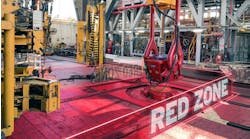Advances in mobile technologies improve collaboration, safety, and training
Manuel R. Suarez
Kumana & Associates
The recent boom in shaleoil and gas production has brought a surge in demand for qualified experienced professionals. Conventional gas production and processing, a large percentage of it in offshore projects, has also contributed to this surge in demand. HR services often report shortages and difficulties filling positions in the upstream sector, particularly in the offshore segment.
Two other factors also play significant roles in this scenario. One, affecting the industry in general, is the high percentage ofskilled personnel reaching retirement age. The other has to do with the fact that the offshore segment usually deals with new technologies, equipment, and systems, many of which are being implemented for the first time. Obviously, "experienced people" are a work in progress.
The following are some of the critical issues faced by offshore control and automation:
- Scarcity of experienced technical personnel
- Rapid development and availability of new or improved software, and hardware being applied to new processes, equipment, and systems
- Little or no availability of training time, aggravated by the remoteness of the sites where the most effective on-the- job training should be delivered
- Original equipment manufacturers' service personnel is also scarce, expensive, and often not readily available at remote locations
- Projects are under very tight implementation timelines and budgets, often aggravated by severe weather conditions.
The results are project delays, downtime, and safety issues. Accidents and equipment failures that may involve environmental impact are especially critical in offshore sites where mitigation is expensive and difficult at best.
Advances in communications, mobile technologies, and applications may provide a way to tackle these issues. The following approach describes a plan of implementation and the potential hurdles along the way.
Tools for delivery
Increasingly, smart phones and tablets are being used with suitable ratings for their likely areas (e.g. Ingress Protection [IP] 65 or better, Class 1/ Div. 2 certified). There are various options already on the market and more are in development. A good example is alarm-management applications for smart phones. There are also offerings for process auditing, equipment monitoring, surveillance, and training.
It should be clear to the manufacturers and providers of equipment and systems that simply offering one-way (view or download) data and information (brochures, manuals, etc.) on a company website is no longer enough. Original equipment manufacturers (OEMs) need to make use of suitable applications to offer two-way capability for "on-site/real-time" data, information, and support for operations (manuals, setup, and safety procedures), maintenance (on-line condition monitoring, diagnostics, trouble shooting, repairs, and parts orders) and personnel training.
Features that should be offered include:
- Secure and efficient access/retrieval of data and information from the field from company or cloud-based servers (e.g. adequate encryption, user-friendly HMI and GUI for end-user field personnel)
- Fully collaborative environment. Field personnel will need not only to view and retrieve data/info, but also to upload material required for training, trouble shooting, diagnostics, order placing, etc.
- Robust document management and control tools. This is a key feature in a truly collaborative environment. Obsolete and/or incorrect documentation is very often the cause of substandard performance in operations and maintenance that can result in accidents, safety issues, and violations
- Asset management tools, including collaborative support, on-line monitoring, maintenance scheduling, diagnostics, trouble shooting, and field repairs assistance (in control and automation, this is mostly remove-and-replace, which facilitates remote assistance).
Even for OEMs with limited product lines, to mount their products and services on this type of platform is a costly and time-consuming effort. Qualitatively, it is clear that there are many benefits, including superior customer support and continuous feedback from the field on the performance of their products to help improve and upgrade design.
The problem may lie in quantifying the benefits – demonstrating the effect of a given application on revenue and profit – so investment funds can be properly allocated.
There are already a significant number of suitable third-party applications in the market, many of which offer good capability and support to customize them for specific products and services, and for integration with other third-party products. In some instances, there may be the need for an OEM to develop its own applications.
Implementation of these solutions will in some cases require some degree of customer cooperation and investment, such as personnel time. However, most of the effort to develop them should be undertaken by the OEM alone. In some instances, sharing development efforts with selected customers has resulted in ownership conflicts over the resulting products, especially if the applications gave the end-user a competitive edge in its specific market.
For the end user
The hiring focus should be on personnel with solid core knowledge in their respective engineering or technical specialties. This should enable them to effectively interact with the OEM's subject matter experts for training and support on operations, maintenance, and management of their products. Experience with specific equipment and systems are highly desirable but may be very hard to come by.
Solid core knowledge, combined with the support systems described above, should result in almost negligible learning curves. Also, training would be delivered mostly on the job, where it is most effective.
The end user should establish metrics and criteria to evaluate and rank offers from OEMs and suppliers regarding on-line/real-time tools, and include this in requests for proposals and quotations. In the selection process, "points" should be awarded to best offers.
For end users, quantifying the value of a given tool is also difficult. However, at least a qualitative scale should be established and used as part of the selection criteria. This is fundamental as an incentive in order to help OEMs visualize potential revenue from developing and implementing these solutions.
End-user contribution is also needed to facilitate feedback to OEMs. On-line real-time monitoring, including video, is often viewed as risky by end users (e.g., productivity and reliability data can be extracted by these features). However, current technology offers adequate security to avoid violations in this regard, and the benefits far outweigh the risks. For example, consider the traditional rule in the industry that "operations executable commands cannot be issued remotely." This type of command requires that the operator issuing it be onsite, the reason being that not only data is needed to issue it but, for safety reasons, visual contact with the equipment is mandatory. However, in offshore operations, this can be difficult due to weather conditions and/or emergency procedures being put in effect. With the advanced monitoring, imaging, and security tools described, a mobile device could conceivably be used in many of these cases.
There are many benefits and advantages in the use of these tools. The technology and the means to implement it exist, and many examples are already in use in various degrees of application. With proper cooperation and mutual incentives between OEMs and end users, no doubt their use will soon be the norm.


